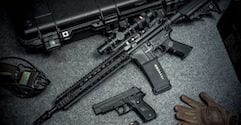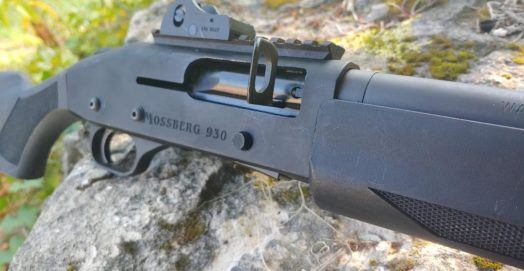7mm Remington Mag Vs. .300 Winchester Mag: Which Round Is The Best

Magnum calibers like the 7mm Rem Mag, .300 Win Mag, .338 Win Mag, .300 Weatherby Mag, and others have exploded in popularity in the last few decades. A lot of which has to do with the better, more affordable optics that allow shooters to take advantage of these long-range rounds.
There is also more interest in longer range hunting and shooting in general, as well as more hunters going after big game such as brown bears and moose.
And of course, these bigger calibers are just plain fun.
With all the increased interest in magnum calibers, it makes sense that there would be some debate about which ones are superior, particularly when it comes to ones that are similar. Which brings us to our topic today: 7mm Rem Mag vs .300 Win Mag.
These two cartridges are without a doubt the most popular of the belted magnum cartridges in America, and while their popularity may be diminished a little overseas, they’re still present everywhere long-range shooting and big game hunting occur.
Today, we’re going to take an in-depth look at these two cartridges and see how they compare while discussing strengths, weaknesses, and other things to note about these two awesome rounds.
Contents
 Image courtesy of Palmetoo State Armory[/caption]
Image courtesy of Palmetoo State Armory[/caption]
This long history of competition between the two has spurred many debates online and in hunting lodges the world over, so let’s dig into what separates these two rounds and why you might pick one over the other.
Price
If you’re looking to make an easy decision and just go with whichever one is cheaper, I’ve got some bad news for you. 7mm RM and .300 WM are so popular, and there’s so much competition in the factory ammo market that prices for the two rounds are basically the same, given equivalent levels of quality.
For example, let’s look at one of my preferred factory hunting ammo lines, Hornady’s Precision Hunter. The cheapest I can find the 162gr 7mm RM Precision Hunter ammo for is $33.45 for a box of 20, or $1.67/round. For the 200gr .300 WM Precision Hunter, I found prices at $32.99 for a box of $20 or $1.63/round.
And don’t think that those prices won’t change. Tomorrow, 7mm RM might be cheaper, it all just depends on the market, and which retailer has what on sale, or in stock.
This does do a good job of illustrating my point though, and that is the fact that you can’t declare one of these rounds a winner over the other based on price.
Edge: It’s a tie, they’re too close in price to call.
Availability and Factory Options
What about availability of ammo and factory options?
Every major ammo manufacturer and most of the minor ones have multiple loadings for both of these calibers, which makes sense given their popularity.
You have hunting loads, precision match loads, and just general plinking ammo choices in abundance, so the actual process of finding what you need for your given task is just a matter of picking something that you and your rifle like.
That all being said, the .300 WM is the clear winner.
Why? That’s easy: the US military uses it.
The Remington MSR, also known in military circles as the Mk 21 Precision Sniper Rifle, was the winner of the US military’s Precision Sniper Rifle contract. The MSR is a caliber-swappable sniper rifle that can quickly be configured to fire the .308 Winchester, .338 Lapua, or the .300 WM.
While there are currently a number of other rifles vying for the spot of the military’s number one sniper rifle, most of the option of firing .300 WM. The military has been using .300 WM for a long time in its M24 rifle and others, and that doesn’t look to be changing anytime soon, certainly not in the next decade unless something drastic happens.
For this reason, .300 WM is a little bit more readily available, and is a little more “future-proof” than the 7mm RM, even though 7mm RM is found all over the world and in every gun store, and isn’t going anywhere either.

Edge: .300 WM, slightly.
By the Numbers ( Velocity, Drop, Drift, and Recoil)
Because these two rounds are so very similar, we really have to go to the ballistics and dig into the numbers to get an idea of which round is better for what purpose.
First, let’s talk about the cartridge itself. The 7mm RM shoots .284”/7.2mm projectile, and has a case length of 2.5”. It has a max overall length of 3.29” and has a case capacity of 83.2gr H20.
By comparison, the .300 WM shoots a .308”/7.8mm projectile, has a case length of 2.62”, and a max overall length of 3.34”. Case capacity is 90.4gr H20. Both use the same size rim and the same belted case head.
As you can see, these two rounds are externally very similar, with the .300 WM being slightly larger overall. This gives the .300 WM a bit of an edge for reloaders who can get a little more oomph out of their loads with the larger case size as compared to the 7mm Rem Mag. That, coupled with the huge variety of .308” bullets means that the .300 WM is a great cartridge for reloaders, especially given its long brass life, and high cost of factory ammo.
Of course, the biggest difference, and really the main difference between these two rounds, is in their projectiles.
The 7mm RM fires a smaller diameter, and in general a lighter bullet. 7mm RM bullets span the range from 139-175grs, and the 140gr, 160gr, and 175gr options are typically the most popular, and readily available.
The .300 WM, on the other hand, can be topped off with up to 230gr bullets, or anything in the 150-230gr range, with 180, 190, and 200gr loads being the most common.
What does that mean for the ballistics of the round?
Well, the smaller, lighter bullets of the 7mm RM have both a higher velocity, and a higher ballistic coefficient, which means the 7mm RM is going to have less drift due to wind, and less drop due to gravity.
How much less? Well, a 7mm RM 162gr Hornday ELD-X bullet in their factory-loaded and widely-available Precision Hunter line will leave a 24” barrel at about 2940fps. The bullet has a very high BC of .631.
On the other hand, a 200gr .300 WM Precision Hunter round will spit the same ELD-X projectile out at 2850fps and 3607ft/lbs of energy from the same length barrel. This projectile has a BC of .597.
Now, what does that all mean? Well, the higher velocities of the ELD-X means less drop due to gravity and the higher BC means it fights the wind better. However, the difference isn’t huge.
Out to 700 yards the rounds are really neck-and-neck, and at that distance, these two rounds are within about a foot of each other as far as drop goes, but the 7mm RM does have an advantage. For most long-range shooters though, that extra drop isn’t that much of an issue. Drop is easy to compensate for.
What about drift due to windage?
Estimating wind is one of the hardest things to do in long-range shooting. Short of having windage flags every 100 yards all the way to a target, you really just have to get good at reading the wind and practice.
Of course, using a bullet that has a high BC fired at a high velocity helps to take a lot of the guesswork out of windage estimation because the wind will have less of an effect on the trajectory of the bullet.
Because the 7mm RM fires a faster bullet with a higher BC, it actually drifts less than the heavier .300 WM bullet. That gives you less to compensate for and improves your odds of hitting the target with that first shot. However, the difference still isn’t that much -only about two inches at 700 yards and about four inches at 1000 yards, with a 10mph crosswind. For hunting, these two rounds drift about the same amount, and while few people hunt at 1000 yards, target shooters and competitors looking for every possible advantage may opt for the 7mm RM.
Another area the 7mm RM wins is in the recoil department. Thanks to the smaller projectile and lower max powder charge, it recoils about 20% less than the .300 WM, given rifles of equal weight. For most shooters, the difference won’t be big enough to matter much, but if you’re prone to flinching or otherwise recoil-sensitive, it’s something you might want to consider.
Edge: 7mm Rem Mag
Hunting and Terminal Ballistics
For hunting, the first part of the equation is hitting the animal in the vitals, which is marginally easier with the 7mm RM. The second part is getting enough penetration and doing adequate damage to those vitals to ensure a clean, humane kill.
Which round is the winner there?
Well, some good indicators of ballistic penetration between the same type of projectiles are velocity, energy, and projectile weight.
We already know that the 7mm RM carries more velocity, but only slightly, and we know that the .300 WM bullets are heavier on average. The key here is energy then.
This is where the .300 WM sneaks out another win. Because of the overall large projectiles, and the fact that you can get 230gr .300 WM projectiles, but 7mm RM tops out at 175gr projectiles. The heavier projectiles of the .300 WM allow you to transfer more energy to the target than the 7mm RM.
One note: given similarly-weighted projectiles, the 7mm RM gets the win because it carries its energy more efficiently downrange, and actually has more energy than the .300 WM after 400 yards. 400 yards is an awfully long way for most hunters though, and even at those ranges, a heavier .300 WM bullet would win out in the energy department.
Edge: .300 WM
Available Rifles
Most mass-produced rifles with a wide caliber selection are going to be available chambered for both of these rounds. Affordable, entry-level rifles like the Ruger American Rifle, Mossberg Patriot, and the Tikka T3 are all readily available wherever guns are sold.

The one edge here is again going to the .300 WM, and only because it’s becoming ever-so-slightly more popular than the 7mm RM, especially with long-range shooting games like the Precision Rifle Series becoming more popular.
Overall Winner and Parting Shots
Overall Winner: .300 WM
These two rounds are extremely close ballistically, and while each has its own advantages, we have to look beyond the ballistics to declare a “winner” and I use that title loosely. The .300 WM gets a slight advantage due to increased factory support, the fact that ammo is ever so slightly more common, and it’s slightly cheaper to reload.
Also, something we didn’t talk about earlier: barrel life in the .300 WM is a lot longer, so you get more bang for your buck, while also getting less barrel wear.
All that combines to make the .300 WM a narrow victor here, but really both of these rounds are great for their intended purpose, and either one will make a fine choice for hunting, target shooting, and the like.













